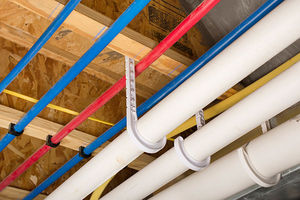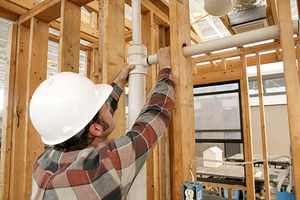 Plastic piping systems have been a part of the construction industry for decades and are primarily used for plumbing applications of carrying fluids to and from fixtures within a building. These systems have unique attributes that provide installers flexibility over traditional metal piping systems. The transition from metal piping systems to plastic systems has led to a major misconception that these materials do not need to be insulated. Though plastic piping systems typically have a better thermal conductivity over metal piping materials, they do not meet the minimum performance requirements set forth in the building and energy codes adopted across North America.
Plastic piping systems have been a part of the construction industry for decades and are primarily used for plumbing applications of carrying fluids to and from fixtures within a building. These systems have unique attributes that provide installers flexibility over traditional metal piping systems. The transition from metal piping systems to plastic systems has led to a major misconception that these materials do not need to be insulated. Though plastic piping systems typically have a better thermal conductivity over metal piping materials, they do not meet the minimum performance requirements set forth in the building and energy codes adopted across North America.
Typical Plastic Piping System Found in Building Construction
- ABS (Acrylonitrile Butadiene Styrene)
- CPVC (Chlorinated Polyvinyl Chloride)
- PB (Polybutylene), PE (Polyethylene)
- PEX (Cross-linked Polyethylene)
- PP (Polypropylene)
- PVC (Polyvinyl Chloride)
- PVDF (Polyvinylidene Fluoride)
Heat transfer is a function of thermal resistance of the installed system (piping and insulation) rather than the thermal resistance of just the piping system. The thermal conductivity of plastic piping ranges from 0.8 to 3.2 Btu · in/h · ft2 · °F and copper piping has a thermal conductivity of 2720 Btu · in/h · ft2 · °F. As noted plastic piping is considerably lower but still significantly higher than the insulation products which have a thermal conductivity of 0.245 -0.27 Btu · in/h · ft2 · °F allowing for greater thermal protection of the piping system. Most building codes and standards require piping systems that that carry fluids that have been heated or cooled to be insulated to lessen heat transfer and reduce energy consumption associated with heating or cooling fluids. These codes do not identify types of piping systems that should or should not be insulated, but rather require all piping systems that convey fluids that have been heated or cooled to be insulated based on Fluid Operating Temperature Range and Usage (°F) and pipe diameter.
Typical Code and Standards Adopted
- International Code Council (ICC) Codes
- IECC-International Energy Conservation Code
- IRC- International Residential Code
- IMC-International Mechanical Code
- ASHRAE 90.1
- Title 24 California Building Energy Efficiency Standards for Residential and Non Residential Building
- UMC- Uniform Mechanical Code
- National Research Council Canada Code
- National Building Code of Canada
 One unique application for plastic piping is hydronic heating systems such as radiant flooring. Plastic piping allows for a continuous and flexible installation while granting the continuity of heat transfer to take place from the piping into the floor and room. This particular application is focused on heating and transferring heat from the piping system into a space, while in contrast, hot water lines are purposed to carry hot fluids to the faucet or distribution point with minimal heat loss. One doesn’t want to heat the wall cavities when taking a shower, thus insulation is used to minimize heater transfer in the delivery of hot water.
One unique application for plastic piping is hydronic heating systems such as radiant flooring. Plastic piping allows for a continuous and flexible installation while granting the continuity of heat transfer to take place from the piping into the floor and room. This particular application is focused on heating and transferring heat from the piping system into a space, while in contrast, hot water lines are purposed to carry hot fluids to the faucet or distribution point with minimal heat loss. One doesn’t want to heat the wall cavities when taking a shower, thus insulation is used to minimize heater transfer in the delivery of hot water.
Building codes not only look at applications but also operational criteria when requiring insulation and the targeted thickness to be installed. The core focus of these codes is to improve energy efficiency of the of the delivery mechanism such as the piping system. Beyond this base function, mechanical and piping insulation provide condensation control in high humidity environments, freeze protection in very cold conditions, as well as some acoustic and vibration control. Insulation added to hot water and service hot water lines can aid in water conservation allowing hot water to reach the faucet at the target temperature, maintain temperature longer between uses and reduce water waste while waiting on hot water to reach the faucet. Insulation is a sustainable product as it does reduce the building’s carbon footprint and aids in the conservation of valuable resources.
Maintaining the integrity and performance is vital over the life of a system and Armacell offers system solutions that incorporate polyethylene and elastomeric insulation products, adhesives, tapes, pipe saddles and pipe supports that can be tailored to performance, code and budget requirements. Piping systems are critical elements of any structure and regardless of their material composition (plastic or metal) they need to be insulated to the requirements defined within the local or regional building code.
To learn more about Armacell’s products please visit www.armacell.us or for direct links into our system solutions please visit www.armacell.us/solutions.
For specific code requirement inquiries associated with your project and energy conservation please contact your local building inspector or permitting office.
